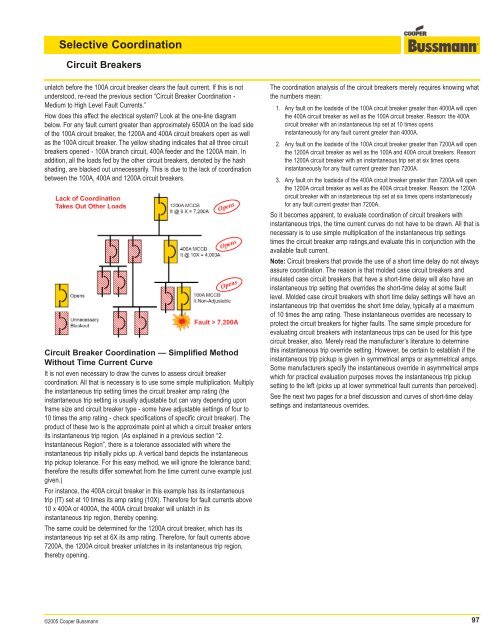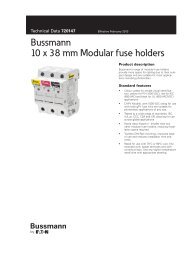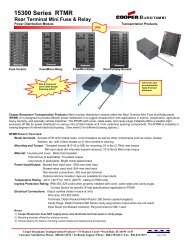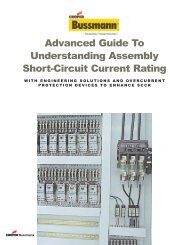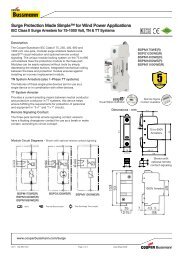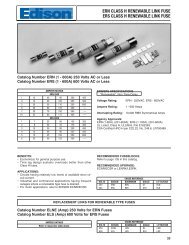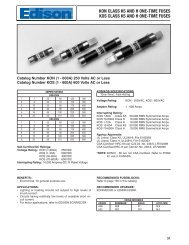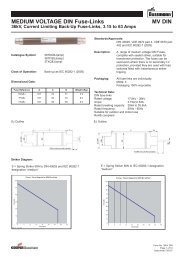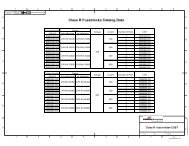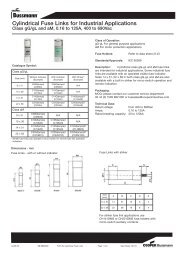Selective Coordination - Cooper Bussmann
Selective Coordination - Cooper Bussmann
Selective Coordination - Cooper Bussmann
You also want an ePaper? Increase the reach of your titles
YUMPU automatically turns print PDFs into web optimized ePapers that Google loves.
<strong>Selective</strong> <strong>Coordination</strong>Circuit Breakersunlatch before the 100A circuit breaker clears the fault current. If this is notunderstood, re-read the previous section “Circuit Breaker <strong>Coordination</strong> -Medium to High Level Fault Currents.”How does this affect the electrical system? Look at the one-line diagrambelow. For any fault current greater than approximately 6500A on the load sideof the 100A circuit breaker, the 1200A and 400A circuit breakers open as wellas the 100A circuit breaker. The yellow shading indicates that all three circuitbreakers opened - 100A branch circuit, 400A feeder and the 1200A main. Inaddition, all the loads fed by the other circuit breakers, denoted by the hashshading, are blacked out unnecessarily. This is due to the lack of coordinationbetween the 100A, 400A and 1200A circuit breakers.Circuit Breaker <strong>Coordination</strong> — Simplified MethodWithout Time Current CurveIt is not even necessary to draw the curves to assess circuit breakercoordination. All that is necessary is to use some simple multiplication. Multiplythe instantaneous trip setting times the circuit breaker amp rating (theinstantaneous trip setting is usually adjustable but can vary depending uponframe size and circuit breaker type - some have adjustable settings of four to10 times the amp rating - check specifications of specific circuit breaker). Theproduct of these two is the approximate point at which a circuit breaker entersits instantaneous trip region. (As explained in a previous section “2.Instantaneous Region”, there is a tolerance associated with where theinstantaneous trip initially picks up. A vertical band depicts the instantaneoustrip pickup tolerance. For this easy method, we will ignore the tolerance band;therefore the results differ somewhat from the time current curve example justgiven.)For instance, the 400A circuit breaker in this example has its instantaneoustrip (IT) set at 10 times its amp rating (10X). Therefore for fault currents above10 x 400A or 4000A, the 400A circuit breaker will unlatch in itsinstantaneous trip region, thereby opening.The same could be determined for the 1200A circuit breaker, which has itsinstantaneous trip set at 6X its amp rating. Therefore, for fault currents above7200A, the 1200A circuit breaker unlatches in its instantaneous trip region,thereby opening.The coordination analysis of the circuit breakers merely requires knowing whatthe numbers mean:1. Any fault on the loadside of the 100A circuit breaker greater than 4000A will openthe 400A circuit breaker as well as the 100A circuit breaker. Reason: the 400Acircuit breaker with an instantaneous trip set at 10 times opensinstantaneously for any fault current greater than 4000A.2. Any fault on the loadside of the 100A circuit breaker greater than 7200A will openthe 1200A circuit breaker as well as the 100A and 400A circuit breakers. Reason:the 1200A circuit breaker with an instantaneous trip set at six times opensinstantaneously for any fault current greater than 7200A.3. Any fault on the loadside of the 400A circuit breaker greater than 7200A will openthe 1200A circuit breaker as well as the 400A circuit breaker. Reason: the 1200Acircuit breaker with an instantaneous trip set at six times opens instantaneouslyfor any fault current greater than 7200A.So it becomes apparent, to evaluate coordination of circuit breakers withinstantaneous trips, the time current curves do not have to be drawn. All that isnecessary is to use simple multiplication of the instantaneous trip settingstimes the circuit breaker amp ratings,and evaluate this in conjunction with theavailable fault current.Note: Circuit breakers that provide the use of a short time delay do not alwaysassure coordination. The reason is that molded case circuit breakers andinsulated case circuit breakers that have a short-time delay will also have aninstantaneous trip setting that overrides the short-time delay at some faultlevel. Molded case circuit breakers with short time delay settings will have aninstantaneous trip that overrides the short time delay, typically at a maximumof 10 times the amp rating. These instantaneous overrides are necessary toprotect the circuit breakers for higher faults. The same simple procedure forevaluating circuit breakers with instantaneous trips can be used for this typecircuit breaker, also. Merely read the manufacturer’s literature to determinethis instantaneous trip override setting. However, be certain to establish if theinstantaneous trip pickup is given in symmetrical amps or asymmetrical amps.Some manufacturers specify the instantaneous override in asymmetrical ampswhich for practical evaluation purposes moves the instantaneous trip pickupsetting to the left (picks up at lower symmetrical fault currents than perceived).See the next two pages for a brief discussion and curves of short-time delaysettings and instantaneous overrides.©2005 <strong>Cooper</strong> <strong>Bussmann</strong>97


